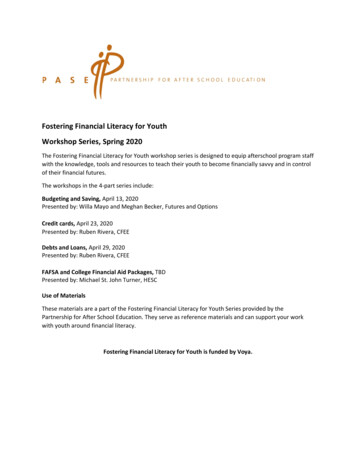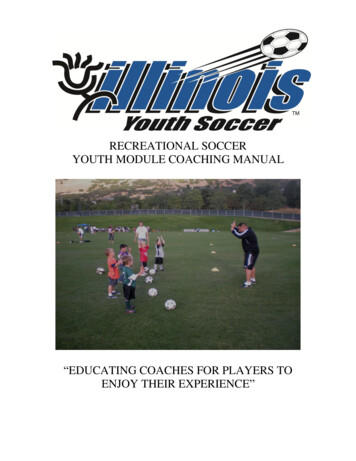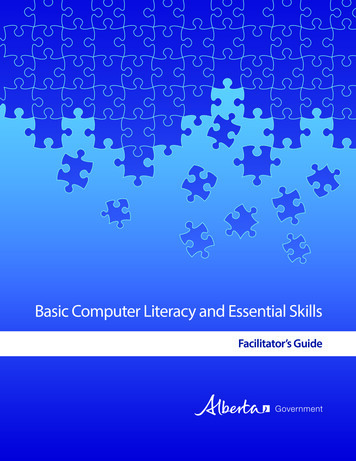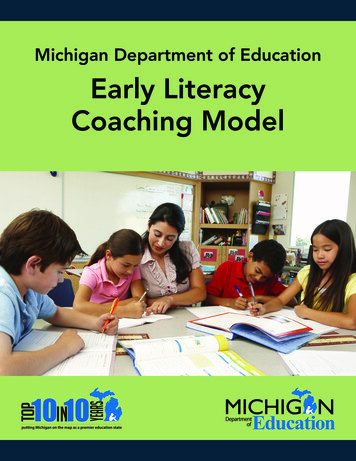
Transcription
Fostering Financial Literacy for YouthWorkshop Series, Spring 2020The Fostering Financial Literacy for Youth workshop series is designed to equip afterschool program staffwith the knowledge, tools and resources to teach their youth to become financially savvy and in controlof their financial futures.The workshops in the 4-part series include:Budgeting and Saving, April 13, 2020Presented by: Willa Mayo and Meghan Becker, Futures and OptionsCredit cards, April 23, 2020Presented by: Ruben Rivera, CFEEDebts and Loans, April 29, 2020Presented by: Ruben Rivera, CFEEFAFSA and College Financial Aid Packages, TBDPresented by: Michael St. John Turner, HESCUse of MaterialsThese materials are a part of the Fostering Financial Literacy for Youth Series provided by thePartnership for After School Education. They serve as reference materials and can support your workwith youth around financial literacy.Fostering Financial Literacy for Youth is funded by Voya.
Step 1: Go To WWW.nearpod.com Step 2: See the RED button that reads “STUDENTS” Step 3: Enter the code: STEP 4: Enter your name. Where it states “Other”enter your professional title.Also, if you have time, download the KAHOOT APP.
Debts and LoansProfessional DevelopmentCouncil for Economic EducationThe Partnership For After School EducationWednesday April 29th, 202010 - 11:30 a.m.Ruben Rivera, PhD
Agenda Introduction and Objectives (5 minutes) EdTech Tools and EconEdLink resources (10 minutes) Understanding good debt and bad debt (20 minutes) Avoiding financial pitfalls (15 minutes) Understanding loans and interests (15 minutes) How to get out of debt and pay off loans (10 minutes) The benefits and risks of student's loans (10 min) Q & A (5 minutes) Survey
ObjectivesIn this professional development session you will Learn about EdTech tools to enhance online learning practices forstudents in K-12. Understand the difference between good and bad debt. Understand loans and interests, including student loans. Best practices for debt management. Learn how to adapt EdTech Tools to lessons for students in K-12. Obtain lessons and resources to help expand your pedagogicalpractices while teaching debts and loans.
Introduction Over ten years experience in teaching financial education in after schoolprograms and at the New York City Department of Education. Director of Professional Development and Master Teacher at the Council forEconomic Education. PhD in Education, my dissertation is on Latino and African Americanstudent community college persistence. Over 15 years experience in taxation Over 15 years experience working in nonprofit organizations.– Harlem Children’s Zone– Children’s Aid– Committee for Hispanic Children and Families
We will explore the following EdTech tools:
Nearpod is aninstructional platformthat merges formativeassessment and dynamicmedia for collaborativelearning experiences. With Nearpod you can: Create interactivelessons Enhance existinglessons and materials Assign Self-pacedlessons Synchronize learningduring live instruction
For example:
Example:Econedlink.org
Google Classroom facilitates paperlesscommunication between teachers andstudents and streamlines educationalworkflow.With Google Classroom you can: Create lessons and postassignments. Organize folders and view work inreal time. Communicate with participatesthrough video, voice, or chat. Much more.
Example:Download the Google Classroom APPOrEnter Classroom Code: fmwfl7
Understanding DebtVocabularyDebt:Something, typically money, that is owed or due.Interest:Money paid regularly at a rate for the use of money lent, or for delayingthe repayment of a debt.
Understanding DebtReading #1 on the national debt: The U.S. debt is the sum of all outstanding debt owed by the federal government. On April 7,2020, it exceeded 24 trillion.1 The U.S. Treasury Department tracks the current total publicdebt outstanding and this figure changes daily. The debt clock in New York also tracks it. About two-thirds is debt held by the public.1 The government owes this to buyers of U.S.Treasury bills, notes, and bonds, including individuals, companies, and foreign governments. The remaining third is intragovernmental debt. The Treasury owes this debt to its variousdepartments who hold government account securities, such as Social Security, which is one ofthe biggest owners. These government account securities have been running surpluses foryears and the federal government uses these surpluses to pay for other departments. Thesesecurities will come due as baby boomers retire over the next two decades. Since SocialSecurity and trust funds are the largest owners, the answer as to who owns the U.S. debt isbasically everyone’s retirement money.Amadeo, 2020, The US Debt and How It Got So Big
Understanding DebtThe Treasury Department sells all bills, notes, and bonds at auction with a fixedinterest rate. When demand is high, bidders will pay more than the face value toreceive the fixed rate. When demand is low, they pay less
U.S. NationalDebt Clockhttps://www.usdebtclock.org/
Understanding DebtReading #2 on Interest: An interest rate is the percentage of principal charged by the lender for the use ofits money. The principal is the amount of money loaned. Since banks borrow moneyfrom you (in the form of deposits), they also pay you an interest rate on yourmoney. Anyone can lend money and charge interest, but it's banks that do it the most. Theyuse the deposits from savings or checking accounts to fund loans, and they payinterest rates to encourage people to make deposits. Banks charge borrowers a slightly higher interest rate than they pay depositors sothey can profit. At the same time, banks compete with each other for bothdepositors and borrowers. The resulting competition keeps interest rates from allbanks within a narrow range of each other.Amadeo, 2020, Interest Rates and How They Work
UnderstandingDebt
UnderstandingDebt
Understanding Good DebtGood debt is an investment that will grow in value or generatelong-term income. Taking out student loans to pay for acollege education is the perfect example of good debt. . Likestudent loans, home mortgages generally have lower interestrates than other debt, plus that interest is tax deductible.Roos, 2020, How Debt Works
Understanding Bad DebtBad debt is debt incurred to purchase things that quickly losetheir value and do not generate long-term income. Bad debtis also debt that carries a high interest rate, like credit carddebt. The general rule to avoid bad debt is: If you can't affordit and you don't need it, don't buy it. If you buy a fancy, 200pair of shoes on your credit card, but can't pay the balance onyour card for years, those shoes will eventually cost you over 250, and by then they'll be out of style.Roos, 2020, How Debt Works
Understanding Debt 301.asp
Sample Lessons on DebtLesson 1: The Role of Government: The National Debt vs. The DeficitLesson 2: Making Sense with Paul Solman: America’s Historical StruggleLesson 3: Taxation and the National DebtLesson 4: Debt Management Debt Course (Next Gen Personal Finance)
Digital Resourceshttps://www.ngpf.org/
The Dangers of Debt and How to AvoidIrby, 2019 states “Credit cards are potentially dangerous, especially for new credit cardusers, who may be fascinated by the allure of what seems like “free” money. Even someexperienced credit card users still fall into credit card traps. If you’re thinking aboutgetting a credit card – or wondering whether to drop your credit cards – understandingthe dangers that come along with credit cards can help you cultivate better credit cardhabits. Know also, that there is a way to use credit cards responsibly and avoid the trapsthat so many consumers have fallen into.L.Irby, The Dangers pf Credit Card Debt and How to Avoid Them, 2019
The Dangers of Debt and How to AvoidStrategies to avoid debt:-Know your temptation to overspend-Interest makes it harder to pay off the balance-Know the risk of getting into debt-Risk of ruining your credit score-Minimum payments creates a false sense of security-Credit cards may lead to credit card fraud-Multiple cards, multiple debtL.Irby, The Benefits of Timely Credit Card Payments, 2019
Avoiding Financial PitfallsNorris, 2019 states, “The most common financial mistakesthat often lead people to major economic hardship can be assmall as not keeping track of your account. Even if you'realready facing financial difficulties, steering clear of thesemistakes could be the key to survival.”
Avoiding Financial PitfallsTen strategies to avoiding financial pitfalls:-Excessive/Frivolous Spending-Never-Ending Payments-Living on Borrowed Money-Buying a New Car-Spending Too Much on Your House/Apartment-Using Home Equity Like a Piggy Bank-Living Paycheck to Paycheck-Not Investing-Paying Off Debt with Savings- Have a PlanRead the full article here
Understanding Loans, Interest and College LoansHow does interest work?Interest is calculated as a percentage of a loan (or deposit)balance, paid to the lender periodically for the privilege ofusing their money. The amount is usually quoted as an annualrate, but interest can be calculated for periods that are longeror shorter than one year.How much do you pay or earn in interest? It depends on: The interest rateThe amount of the loanHow long it takes to repay
Understanding Loans, Interest and College LoansSimple InterestExamples:To calculate simple interest, use this formula: Principal x rate x time interest For example, say you invest 100 (the principal) at a 5% annual rate for one year.The simple interest calculation is: 100 x .05 x 1 5 simple interest for one year 100 x .05 x 3 15 simple interest for three yearsUse this tool
Understanding Loans, Interest and College LoansCompound InterestCompound interest (or compounding interest) is interest calculated on theinitial principal, which also includes all the accumulated interest from previousperiods on a deposit or loan. Thought to have originated in 17th century Italy,compound interest can be thought of as "interest on interest," and will make asum grow at a faster rate than simple interest, which is calculated only on theprincipal amount.
Understanding Loans, Interest and College Loans
UnderstandingLoans, Interestand CollegeLoans
UnderstandingLoans, Interestand ator.html
Understanding Loans, Interest and College LoansLoans:A loan is money, property, or other material goods given to another party inexchange for future repayment of the loan value or principal amount, along withinterest or finance charges. A loan may be for a specific, one-time amount, or itcan be available as an open-ended line of credit up to a specified limit.What are some types of loans?
Understanding Loans, Interest and College LoansStudent LoansNeed-Based LoansFederal Perkins Loans may be awarded by colleges to students with the highest need.Federal Direct Subsidized Loans are interest-free while you're in college and have aborrowing limit that increases for each year of school you complete.Non-Need-Based LoansFederal Direct Unsubsidized Loans charge interest, but allow you to add the interestfees to the amount you borrow until after graduation. However, doing this means you’llactually end up owing more.Federal Direct PLUS Loans allow parents (or graduate students) to borrow the total costof college, minus any financial aid received.
Understanding Loans, Interest and College LoansStudent LoansState Loans To learn about college loans that may be available from your state, use the contact informationon the U.S. Department of Education's list of state higher-education agencies.Private Loans In general, private loans are not subsidized or need-based. They also often require a cosigner— someone who promises to repay the money if the student fails to do so. The interest ratesof private loans vary: Banks and other financial institutions usually have the highest interest rates. Some private organizations and foundations offer lower interest rates. Use our ScholarshipSearch tool to find these. Some colleges offer loans with relatively low interest rates.
Understanding Loans, Interest and College Loans
Understanding Loans, Interest and College LoansStudent LoansReading #3Today more than 44 million Americans have outstanding student loan debt, which hasbecome the one of the biggest consumer debt categories. All told, student debt in theU.S. now totals more than 1.5 trillion. For South Dakotans, more than 109,000borrowers hold 3.3 billion in total outstanding federal student loan debt, according torecent data from the Department of Education. That averages out to more than 30,000 per borrower. In Virginia, more than 1 million borrowers hold 38 billion intotal outstanding debt. Across America, it’s estimated that the average borrower hasmore than 37,000 in debt, while more than 2 million student loan borrowers owe 100,000 or more — and these figures continue to rise.U.S. Senator Mark Warner, 2019
Understanding Loans, Interest and College LoansDebate:Is a college education worth the debt?
Understanding Loans, Interest and College LoansThat all depends on needs and wants.
The Benefits and Risks of Student Loans
The Benefits and Risks of Student Loans
The Benefits and Risksof Student Loans
Understanding Loans, Interest and College LoansHow to Navigate Student Loans:1. Get a Job and Start Saving Early2. Give High School Your All3. Get College Credit Without Paying for College Classes4. Fill Out Your FAFSA as Soon as Possible5. Look High and Low for Scholarships6. Rethink Your Choice of College7. Avoid Private Student Loans8. Work Part-Time
Understanding Loans, Interest and College Loans9. Take a Semester Off10. Keep Filing Your FAFSA11. Make a Budget12. Avoid Credit Cards13. Find Ways to Reduce Your Costs14. Pick Your Repayment Plan15. Look Into Forgiveness Programs16. Work a Side Gig
Q&A
If you have any questionsplease email me atrrivera@councilforeconed.org
Compound interest (or compounding interest) is interest calculated on the initial principal, which also includes all the accumulated interest from previous periods on a deposit or loan. Thought to have originated in 17th century Italy, compound interest can be thought of as "interes










